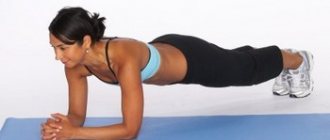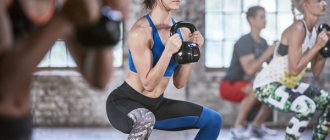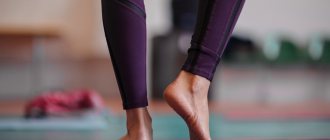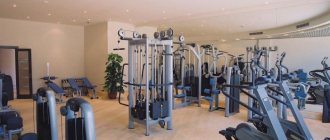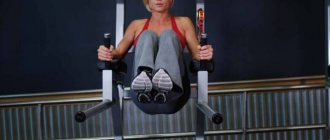Why do you need back training?
The back muscles receive stress throughout the day: when we walk down the street, stand in public transport, sit for a long time behind the wheel and at work, carry heavy bags. The muscular corset constantly maintains our spine in the correct position, and for those who do not pay enough attention to back training, even a day without much physical activity often seems tiring.
Moreover, lack of back training affects our posture, gait, and even the technique of performing any fitness exercises. It reduces muscle tone throughout the body.
“For me, as a trainer, it is enough to see a person from the back to understand whether he is engaged in fitness or, say, dancing, whether he generally looks after his health and himself in general,” says Olga Kochetova , fitness manager of a personal training studio for a network of clubs "Planet Fitness". “So be sure to include back exercises in your workout plan.”
First gymnastics exercises. Warming up in bed
You need to start performing a set of exercises immediately after the alarm rings, without getting out of bed: the body should wake up gradually.
- The first of the gymnastic movements do not go beyond the usual actions after waking up. As soon as the alarm clock rings, you need to start stretching, kneading and stretching your ligaments and muscles.
- The second step should be twisting the body: the upper part of it is directed to the left, while the lower part is directed to the right.
- Then the exercise is repeated, only parts of the body are turned in directions opposite to those in which they were directed previously. The third exercise involves pulling your legs towards your stomach: this is useful, among other things, for strengthening blood vessels, and also helps normalize blood circulation.
Morning exercises for weight loss at home should begin when the alarm clock rings
This type of training makes your back and abdominal muscles stronger; in addition, it allows the whole body to get the warm-up it needs before the main part of morning exercises.
Back training: which fitness is suitable
Any. If you don’t just fanatically strengthen your back alone, but harmoniously work the muscles of your whole body. “As for back training specifically, it is necessary to pay equal attention to external and internal muscles,” notes Anna Motyzheva, instructor at the X-Fit fitness club. “Pilates exercises and swimming will help to work out the internal muscles that support the spine,” says Olga Kochetova. “And the motor muscles – the latissimus, trapezius and rhomboids, the teres major and minor, and the rear deltoid, which are actively involved in most movements in life and sports and create a beautiful back shape – will strengthen various pull-ups and rows.”
Pilates, it is worth noting, is generally an irreplaceable thing for back training for a number of reasons: the load on the joint-ligamentous apparatus is minimized, deep muscles that are not involved in regular training are perfectly activated, and back pain goes away.
Why is it necessary to increase the strength of your back muscles?
The main feature of skeletal muscles is that without proper load they atrophy. The process of their destruction and exhaustion goes unnoticed, but with frightening consistency.
A person easily adapts to the loss of muscle mass; he begins to avoid situations where maximum muscle tension is necessary. But this trick does not work with the spinal muscles, because it is impossible to completely eliminate or significantly reduce the load on the spine. This happens for this reason.
A person without excess weight, when standing straight, experiences a load on the lumbar spine - 30 kilograms. A slight bend forward - the load doubles. When the torso is bent at an angle of 90 degrees, the pressure on the disc increases to 210 kilograms. The spine cannot cope with such a large natural load without the help of strong muscles.
We must remember that there are deep muscles and external muscles on the back. The extrinsic musculature (trapezius and latissimus muscles) looks efficient, but it does not serve the function of supporting the spine. This function is assigned to the internal muscles of the back, which are attached to the vertebrae and ensure the desired position of the spinal column. These are the muscles that need to be trained to ensure a healthy spine.
Photo: pixabay.com
The conclusion itself suggests itself: training the back muscles is not an excess, but a necessity for every person.
1. Lie on your stomach, legs connected, arms extended to the sides, forehead resting on the floor. Exhale. As you inhale, raise your arms, legs and head, looking forward. Hold your breath for a few seconds, then relax, exhale and return to the starting position. Perform 5-7 repetitions.
2. We lie down on our stomachs. We place our palms on the floor near the shoulders and push up from the floor, keeping the torso straight. Focus on the hands and toes. Shift your body weight to your right hand, and extend your left hand forward, focusing your gaze on the fingers of your left hand. Count to three, then switch hands. If you are not strong enough to support your body weight with one hand, start with your forearm instead of your hand. Or simply transfer your body weight first to one hand and then to the other without lifting your hands from the floor. Perform the exercise in this version until the muscles become stronger. Do 5-15 times for each hand.
3. Lying on your back, bend your knees and place your feet as close to your buttocks as possible. Spread your legs slightly. Place your hands along your body, palms down. As you inhale, lift your hips and pelvis as high as you can so as not to experience tension or discomfort. The shoulders remain pressed to the floor, and the back arches slightly. Hold your breath for a few seconds, then slowly lower your torso and exhale. Perform 5-10 times.
4. Standing on all fours, we rest on our knees and palms. Alternately, raise the straight leg back with fixation at the end point for 3-5 seconds. Perform for each leg 5-10 times.
5. Lying on your stomach, arms along your body, hands clenched into fists and thumbs pressed to the floor. Slowly raise your straight left leg up and hold it for a few seconds. Perform 5-10 times for each leg.
The suggested physical exercises should be performed every other day or two, in the morning or evening. Many people make a mistake: in a hurry to get a positive result from classes, they do them every day.
Photo: pixabay.com
This physical training regimen only leads to muscle wasting, which will, on the contrary, contribute to the appearance of back pain. To get the maximum result from muscle training, you need proper rest - this means sleeping for 6-8 hours on a semi-rigid bed.
The proposed exercises can be divided into 2 parts and performed on different training days. On free days, regular exercises that increase the flexibility of the muscles and ligaments of the spine will be very useful.
Tags: muscles, spine, back, exercises, muscle training, exercise, physical training, regular exercise, back pain, spinal muscles
Back training: how to shape your figure
Although we found out that the back is not the most problematic area, fat can accumulate, forming unsightly folds, here too. In addition, some women have naturally very wide chests.
“Removing back fat can only be done as part of general weight loss,” says Natalya Sorokina , instructor at the X-Fit fitness club. “Moderate or high-intensity cardio or aerobic training, which should be done 5-7 times a week for at least 30 minutes, will help with this.”
“If we talk about the visual imbalance that occurs in girls with thin legs and a heavy, plump top, then you need to actively pump up the muscles of the legs and buttocks - this will make the figure more harmonious,” adds Olga Kochetova.
A few rules for morning exercises
1. Exercises should be done immediately after waking up.
The body and brain may resist, but this is necessary. Wash your face and run to exercise. Believe me, after a few exercises the body will begin to wake up and the mind will begin to clear up. Gradually you will get used to doing exercises in the morning.
2. Gymnastics should be short.
There is no need to starve yourself with an hour-long workout in the morning, otherwise you will not wake up and will be even more tired. 15-20 minutes is quite a suitable duration.
3. Exercise should meet your goals.
In addition to general warm-up exercises, you can pay attention to problem areas. Want to keep your butt in shape? This means that you should include squats and lunges in your morning exercise routine. If you want to get rid of your belly and abs, then abdominal exercises will help you.
This does not mean that the entire complex should be used to pump up the muscles you need, but you can pay attention to problem areas with the help of 2-3 special exercises.
The main thing in morning exercises is systematicity, and even when you want to sleep more than ever, you need to get up and do exercises. You will wake up, your body will be fine, and the pride that you got up and started exercising will be off the charts.
Don't get carried away with back training
It is difficult to pump up your back in the literal sense of the word, that is, to make it visually larger. But overstraining muscles during training, reaching the point of discomfort and pain, is quite possible.
The correct technique and optimal training and recovery regime will help you avoid this. “During class, be sure to alternate strength exercises with spinal traction and stretching movements. Then the back muscles will become stronger and more resilient, flexibility will improve, and the back will not look very massive,” recommends Anna Motyzheva.
A set of exercises for morning exercises.
Gymnastics is done from top to bottom, that is, we begin to warm up the neck and arms first and end with the feet.
Basic exercises for the neck and head.
Each exercise should be done 4-5 times in each direction.
Charging for arms and shoulders:
- Rotate your shoulders forward and backward 5 times in each direction.
- Working on the hands - clench your palm into a fist, so as to hide your thumb in the fist. Spread your arms to your sides and rotate your hands 5 times in each direction.
- Rotation in the elbow joints - straighten your hands, bend your elbows, rotate your elbow joints 4-5 times in one direction and the other.
- Shoulder Rotation – Keep your sides parallel to the floor. Starting with a small amplitude, rotate your arms forward, drawing imaginary circles, gradually increasing the radius. When you reach the largest amplitude, begin to rotate your arms in the opposite direction, reducing the radius to the smallest.
Important: In this exercise it is important to keep your arms tense.
Exercises for the torso: Exercises for the legs. Back exercises:
We will do all back exercises while lying on the floor.
These exercises are quite enough to warm up the body. Then you can include exercises for other muscle groups, for example,
Morning exercises are one of the important components of the weight loss process.
According to experts, it is not only great for losing excess weight, but will also quickly awaken the body, allowing sleepy muscles to recharge with energy on the eve of a new day, replace the usual cup of coffee, keep the skin toned and lift your spirits.
In order for morning exercises to bring maximum benefits for weight loss, the exercises must be performed in strict accordance with the rules prescribed by specialists.
- Regularity: if you miss even a day, fitness professionals say, the body has time to wean itself off the gymnastic movements; daily routine is one of the keys to success in the difficult task of losing weight.
- Accuracy: morning exercises that help you lose weight should not be too difficult to perform for the person doing it, because its goal is not to build a mountain of muscles, but to burn extra calories. Typically, charging lasts no more than 20-30 minutes.
- Mode: under no circumstances should you have breakfast before charging! If you first devote time to eating, and only then start trying to train the body to lose weight, the desired effect will not be achieved.
Important detail! Morning exercises suggest that rest between exercises performed within its framework should take no longer than 1 minute.
Otherwise, calories will be burned more slowly than necessary for weight loss, and you should no longer expect the desired result.
Remember safety precautions
For those who have certain back problems, trainers advise, first of all, to consult a doctor. And secondly, remember about safety precautions.
“If you have problems with the spine (hernia, protrusion, scoliosis), avoid axial loads, work with heavy weights and better train under the supervision of a personal trainer or sports doctor. When performing exercises on your own, always make sure to maintain a neutral position of the spine, keep your back straight when bending and pulling,” says Olga Kochetova.
Regularly pay attention to back training. And you will see how your posture will change for the better, you will become more graceful and you will be much less tired.
Pre-warm-up
Even before a light workout, you need to stretch and warm up your muscles. In addition, the body will receive an additional supply of oxygen, which can prevent the occurrence of pain during basic activity. Pre-warm-up before exercise to strengthen the back and spine includes the exercises described below:
- Stretching. In the starting position, the back is straight. Next, you should raise your arms up and stretch, and then lower them and relax.
- Feet are placed shoulder width apart. Your hands should be placed on your belt, and after a deep breath, take them back to the maximum possible distance. During the reverse movement, exhale and return to the starting position.
- For the next exercise, you can use a chair. It is necessary to rise on your toes, lightly holding onto this or any other suitable object with your hands.
- At the end of the warm-up, you can do some walking in place. You shouldn’t strain yourself too much, but for greater efficiency, raise your knees as high as possible.
Muscle stretching complex
Regularly performing such exercises will reduce tension, improve blood circulation and help prevent the development of chronic diseases. The complex is perfect as a daily morning exercise for the back and spine:
- Exercise "hang". To perform this you will need a simple horizontal bar or wall bars. The technique is quite simple. You need to hang on outstretched arms with your legs lowered to the floor. The execution time depends on the endurance and preparedness of the body. The number of repetitions is optional.
- Exercise "cat". In the starting position, the arms are lowered along the body, and the legs are placed shoulder-width apart. Next, a bend is made with the girth of the knees. Afterwards, the back gradually rises, but the arms do not move. The exercise is named this way because when performed, it produces a kind of cat-like bend. You need to bend down as low as possible, bending at the waist.
- Exercise "ball". Sitting on the floor, clasp your knees with your arms and lower your head to your chest. Next you need to roll on your back eight times.
- Exercise "bridge". It is possible to perform the standard version from both a sitting and standing position. You should hold the bridge for about 15-20 seconds.
Complex in the presence of scoliosis
The workout consists of a number of simple but very effective exercises. In general, exercises for the back and spine with scoliosis include the following activities:
- Rotation of arms in a standing position. The back should be straight and the chest should be straightened.
- Side bends. The legs are slightly wider than the shoulders.
- Hands are gathered in a lock, the back bends forward along with outstretched arms.
- You need to stand on your toes and then on your heels. At the same time, the back is stretched upward as much as possible.
- When lying down, your legs are bent and your arms are crossed over your chest. As you exhale, the body moves forward. Hands rest on the floor and push-ups are performed.
- Get into a position on all fours. The right arm and left leg are raised as you inhale, then repeated with the other pair of limbs.


